
Wetenschap
De Euclid-ruimtetelescoop komt samen
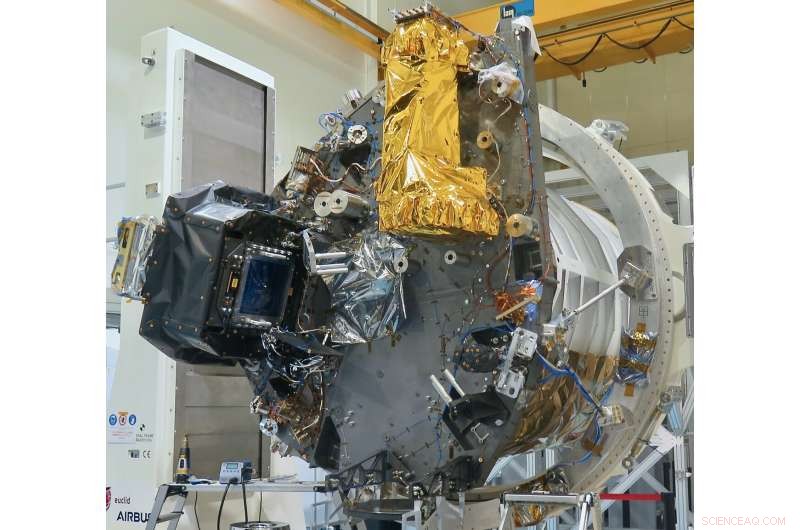
De VIS- en NISP-instrumenten op de payload-module van Euclid. Krediet:Airbus
ESA's Euclid-missie heeft een nieuwe mijlpaal bereikt op zijn reis naar lancering. De twee instrumenten zijn nu gebouwd en volledig getest. Deze zijn geleverd aan Airbus Defence and Space in Toulouse, Frankrijk, waar ze nu worden geïntegreerd met de telescoop om de payload-module van de missie te vormen.
Euclid bestaat uit een 1,2-meter spiegeltelescoop die is ontworpen om te werken op zowel zichtbare als nabij-infrarode golflengten - de laatste is net langer dan het rode licht dat mensen kunnen zien. De telescoop verzamelt licht van verre kosmische objecten en voert het in twee instrumenten.
Het zichtbare instrument (VIS) en de Near Infrared Spectrometer and Photometer (NISP) zullen parallel lopen, tegelijkertijd gegevens opnemen van welk deel van de hemel de telescoop ook is gericht.
Euclid's missie is om de vormen van meer dan een miljard sterrenstelsels te meten, en de nauwkeurige roodverschuivingen van tientallen miljoenen sterrenstelsels over meer dan een derde van de hemel. De roodverschuiving is een effect dat wordt veroorzaakt door de uitdijing van het heelal. Het rekt de golflengte van het licht dat wordt uitgezonden door verre sterrenstelsels uit; hoe verder weg de melkweg, hoe extremer de roodverschuiving. De sterrenstelsels in het onderzoek van Euclides zullen 10 miljard jaar kosmische geschiedenis omvatten, en laat wetenschappers de mysterieuze donkere materie en donkere energie onderzoeken waarvan wordt gedacht dat ze het heelal domineren.
Het VIS-instrument zal de precieze meting van de vormen van sterrenstelsels uitvoeren door de allerbeste beelden te maken van verre sterrenstelsels die mogelijk zijn. Om dit te doen, het instrument maakt gebruik van een mozaïek van 36 CCD's, die elk 4000 pixels bij 4000 pixels bevatten. Dit geeft de detector in totaal zo'n 600 megapixels.
"Het ontwerp, ontwikkeling, productie, het testen en kalibreren van het VIS-instrument gedurende een tiental jaar volgens een strikte specificatie was een uitdaging, " zegt Mark Kropper, VIS-instrument Leider en professor aan het UCL Mullard Space Science Laboratory, VK.
"We zijn enorm trots op wat het VIS-team heeft bereikt om dit project tot een goed einde te brengen. Dat de uiteindelijke prestatie onze verwachtingen overtreft, is een eerbetoon aan hun expertise, toewijding en professionaliteit."
Niet alleen het aantal pixels is indrukwekkend, het instrument levert ook de beste gevoeligheid bij weinig licht over een breed scala aan golflengten bij lange integratietijden.
"Dit zijn heel speciale CCD's, ze zijn gedurende vele jaren speciaal voor Euclid ontwikkeld, " zegt Alex Kort, ESA's VIS payload engineer.
Het andere instrument, NISP, is gewijd aan het maken van spectroscopische metingen van sterrenstelsels, wat inhoudt dat ze hun licht in individuele golflengten splitsen. Hierdoor kunnen de roodverschuivingen worden afgeleid. Met deze eigenschap kunnen kosmologen de afstand tot de betreffende melkweg schatten, en zal het mogelijk maken Euclid's gegevens om te zetten in de grootste, meest nauwkeurige 3D-onderzoek van het heelal ooit uitgevoerd.
"Het internationale NISP-team en de ondersteunende industrieën hebben een ongelooflijke klus geklaard om te ontwerpen, dit uitdagende instrument ontwikkelen en testen, " zegt Thierry Maciaszek, NISP instrument projectmanager, van CNES en Laboratoire d'Astrophysique de Marseille, Frankrijk.
"Dit is, echter, niet het einde van het verhaal voor ons aangezien veel grote activiteiten met NISP op satellietniveau moeten worden afgerond. We wachten met ongeduld op het eerste licht tijdens de vlucht dat de uitstekende wereldwijde prestaties laat zien."
De NISP-detector zal het grootste gezichtsveld hebben dat ooit in de ruimte is gevlogen voor een infraroodinstrument.
"De kwaliteit van de optiek is gewoon geweldig, " zegt Tobias Boenke, Mission System &NISP Instrument Engineer bij ESA.
Een belangrijke factor bij het bereiken van de uitzonderlijke optische nauwkeurigheid van Euclid was een beslissing die vroeg in de geschiedenis van het project werd genomen om de volledige module met nuttige lading uit siliciumcarbide te bouwen. Het gebruik van dit materiaal bij ESA was een pionier bij de fabricage van de telescoop voor de ruimtemissie Herschel. Op de Gaia-missie van ESA, de draagstructuur voor de subsystemen van het ruimtevaartuig werd op een frame van siliciumcarbide gemonteerd. op Euclides, het materiaal is gebruikt voor zowel de instrumenten als de telescoop.
Terwijl metaal uitzet en krimpt als de temperatuur verandert, waardoor het vermogen van een optisch systeem om licht te focussen afneemt, siliciumcarbide is extreem stabiel tegen dergelijke temperatuurschommelingen. Maar het gebruik van de verbinding brengt zijn eigen uitdagingen met zich mee. Silicon carbide is a ceramic and so much more brittle than metal.

The supporting structure of the telescope’s secondary mirror for ESA’s Euclid spacecraft being brought together for final integration and optical alignment at Airbus in Toulouse, Frankrijk. Krediet:Airbus
"It was a big challenge to be able to manufacture the instruments from this material and make sure they can remain undamaged during the launch, " adds Tobias.
Like VIS, NISP also uses specially designed state-of-the-art detectors to record the faint light coming from distant stars and galaxies. Unlike VIS, NISP can also operate in spectrographic mode. The detectors, which are operated at –180°C to provide ultra-low noise and high sensitivity, register these 'spectra' and convert them into tiny electronic signals. These signals can then be amplified and accurately measured to provide the photometric and spectroscopic redshifts.
The instruments will receive light from Euclid's telescope, which has already been assembled at Airbus, Toulouse. Like the instruments, it too is made from silicon carbide and is a state-of-the art construction in all senses.
"We are pushing all the manufacturing levels to the limit, " says Luis Miguel Gaspar Venancio, ESA's Mission Performance &Optical Systems Engineer.
A special component behind the telescope, called the dichroic, separates the collected light and diverts the visible wavelengths to VIS and the infrared wavelengths to NISP.
When the information from VIS and NISP is combined, scientists will be able to deduce the way that the Universe's large-scale distribution of galactic structures has built up throughout cosmic history. This will help them determine the speed at which such structures grow, providing strong constraints on the nature and amount of dark matter and dark energy in the Universe.
The instruments were prepared for delivery to Airbus just before the COVID-19 pandemic imposed restrictions and lockdowns in many ESA member states. Gelukkig, VIS was already at Airbus, and NISP had to wait for a few weeks for shipment from Marseille to Toulouse, but was not on the critical path.
"I am extremely grateful to all project parties:institutes, industry and colleagues at ESA for their dedication and commitment during these difficult times, " says Giuseppe Racca, ESA's Euclid project manager.
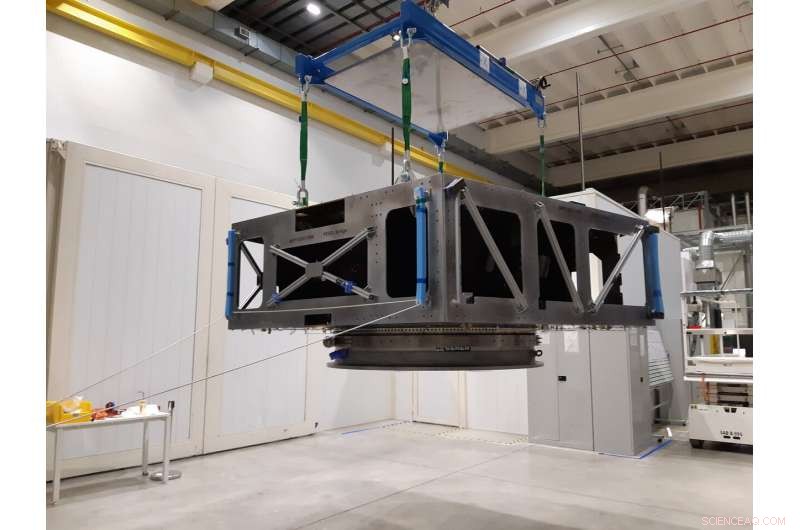
The flight model of ESA’s Euclid mission’s service module being moved in the clean room at Thales Alenia Space in Torino, Italië. Credit:Thales Alenia Space Italy
"We were hit by the pandemic in a particularly critical moment when both VIS and NISP were to be transferred to industry. Despite the work and travel restrictions a concerted effort by all parties allowed to minimize the delays by implementing distributed and sequential integration activities of the instrument units and remote monitoring."
Now that the instruments have been delivered to Airbus, they will be integrated first with the telescope, and next with the rest of the payload module. It has been a long journey getting this far. Euclid was selected for implementation in 2011, having already undergone almost five years of studies. While there is still a lot of hard work and testing ahead, the delivery of the instruments and telescope means that the spacecraft can really begin to come together.
"Eindelijk, we have something in front of our eyes, " says Luis Miguel. "It's not just paper anymore. It's a fantastic piece of hardware; beautiful in a way."
Integrating the payload module will last several months as it is painstaking work to get everything bolted together, precisely aligned and electronically talking. The instrument's control units have already been mechanically and electrically integrated to the payload module. These tests have verified that the instruments can be properly powered by the spacecraft, can talk to the onboard computers, and can transmit the science data that will then be downloaded to ground through the spacecraft antennas.
Once the telescope has been integrated with the rest of the payload module, it will be shipped to Centre Spatial de Liège, België, for 'end-to-end' testing in a thermal vacuum chamber that can simulate the conditions of space as well as possible on Earth. This test is scheduled to take place in February and March 2021.
Once that test shows that everything is working as expected, the payload module will be shipped to the prime contractor Thales Alenia Space (TAS), in Torino, Italië. TAS has been building the service module, which contains essential systems such as power, propulsion and communications.
The service module's main structure recently passed its structural and thermal tests and is now ready to have the various systems integrated inside. TAS will begin by laying down the pipelines for the propulsion systems, and the cabling for other distributed systems. Flight electronics, inclusief computers, power units, and attitude control units, are already mounted on their own structural panels and these will now be installed inside the main structure. Integration is due to be complete in the third quarter of the year, at which time tests will be performed.
TAS will then integrate the payload module with the service module to form the final, finished spacecraft. Vervolgens, another round of tests will ensure that everything is working together properly. Op dat punt, the spacecraft is essentially finished, and ready for launch.
Launch is currently scheduled for the second half of 2022 from Europe's spaceport, Kourou, Frans Guyana.
 Een 3D-geprinte bioresorbeerbare luchtwegstent maken
Een 3D-geprinte bioresorbeerbare luchtwegstent maken Wetenschappers ontrafelen de mysteries van onomkeerbaarheid in elektrochrome dunne films
Wetenschappers ontrafelen de mysteries van onomkeerbaarheid in elektrochrome dunne films Methoden voor het maken van kristallen voor een wetenschapsexperiment voor kinderen
Methoden voor het maken van kristallen voor een wetenschapsexperiment voor kinderen Voorbeelden van chemische synthese
Voorbeelden van chemische synthese Wat gebeurt er wanneer ijs aan heet water wordt toegevoegd en hoe zal de energie veranderen?
Wat gebeurt er wanneer ijs aan heet water wordt toegevoegd en hoe zal de energie veranderen?
 ijskoude arctische lucht, winterstormen grijpen een groot deel van ons aan
ijskoude arctische lucht, winterstormen grijpen een groot deel van ons aan Wetenschappelijke richtlijnen om chemische ongevallen te voorkomen en te beperken
Wetenschappelijke richtlijnen om chemische ongevallen te voorkomen en te beperken Duizenden vluchten terwijl een nieuwe tyfoon de Filippijnen bedreigt
Duizenden vluchten terwijl een nieuwe tyfoon de Filippijnen bedreigt Nieuwe studie helpt stille aardbevingen langs het Noordereiland van Nieuw-Zeeland te verklaren
Nieuwe studie helpt stille aardbevingen langs het Noordereiland van Nieuw-Zeeland te verklaren Opflakkeringen en verwijdering van korst in het noordoosten van Japan
Opflakkeringen en verwijdering van korst in het noordoosten van Japan
Hoofdlijnen
- Het verzoenen van taxonveroudering met de Red Queens-hypothese
- Lijst en beschrijf de vier hoofdklassen van moleculen
- Kan glucose door het celmembraan diffunderen door eenvoudige diffusie?
- Hoeveel steenarenden zijn er?
- Tonnen leven diep in het aardoppervlak gevonden
- Hoe jaloezie werkt
- Wat is de laatste gemeenschappelijke voorouder?
- Waarom maakt het hebben van te veel opties het moeilijker om te kiezen?
- Duizenden pinguïnkuikens verhongeren op Antarctica
- Team lokaliseert met succes inkomende asteroïde
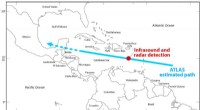
- Foutloos:NASA-vaartuig landt op Mars na gevaarlijke reis

- Eerste onderzoek met satellietgegevens van exoplaneten beschrijft een van de meest extreme planeten in het heelal
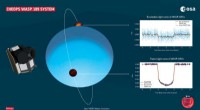
- Nieuwe NASA-studie verbetert zoeken naar bewoonbare werelden

- Afbeelding:Gelaagde afzettingen op de zuidpool van Mars
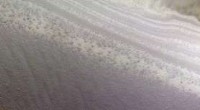
 Een paar eenzame planeetachtige objecten geboren als sterren
Een paar eenzame planeetachtige objecten geboren als sterren Aluminium op weg naar titaniumsterkte
Aluminium op weg naar titaniumsterkte Machine learning voorspelt mechanische eigenschappen van poreuze materialen
Machine learning voorspelt mechanische eigenschappen van poreuze materialen Atmosferische zuurgraad beïnvloedt oceanische ecologie
Atmosferische zuurgraad beïnvloedt oceanische ecologie Tsjechische waarschuwing over Huawei, ZTE-beveiligingsbedreiging
Tsjechische waarschuwing over Huawei, ZTE-beveiligingsbedreiging Afweerkracht van het immuunsysteem gevangen in actie
Afweerkracht van het immuunsysteem gevangen in actie Ruimteweermodel simuleert zonnestormen vanuit het niets
Ruimteweermodel simuleert zonnestormen vanuit het niets Schurkenplaneten:jagen op de meest mysterieuze werelden van de melkweg
Schurkenplaneten:jagen op de meest mysterieuze werelden van de melkweg
- Elektronica
- Biologie
- Zonsverduistering
- Wiskunde
- French | Italian | Portuguese | Swedish | German | Dutch | Danish | Norway | Spanish |

-
Wetenschap © https://nl.scienceaq.com

